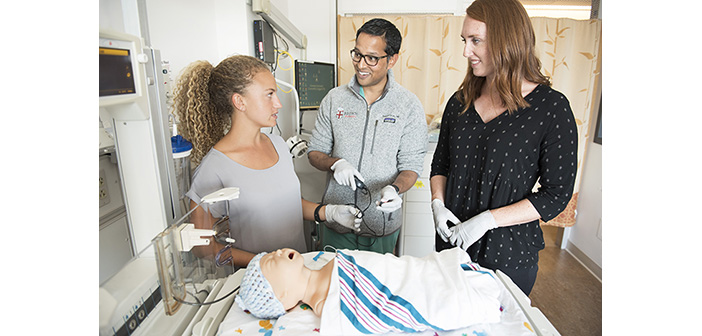Biomedical engineering students devise unique solutions to real-world medical challenges.
At the beginning of the 2017-18 academic year, cardiothoracic surgeon Neel Sodha, MD, walked into a classroom full of Brown University engineering students and presented them with a problem.
While cardiac bypass surgeries save hundreds of thousands of lives every year, some patients are at risk of neurological damage following the procedure, as plaques and other debris break loose from the heart and travel to the brain. Around 10,000 people nationwide suffer these embolic strokes every year.
The devices available to heart surgeons aimed at preventing these strokes—aortic filters designed to capture debris before it exits the heart—simply don’t work as well as doctors would hope. Sodha, an assistant professor of surgery and director of cardiovascular ICU at the Lifespan Cardiovascular Institute, challenged the students to come up with something better.
A team of five students from the class—a senior capstone course required for all Brown biomedical engineering concentrators—took up that challenge. Through the fall semester, they designed a new aortic filter, built a prototype, and performed computational and benchtop tests to assess the safety of the device and its efficiency at capturing embolic debris without impeding blood flow.
Their testing suggests that their device, dubbed Embonet, is effective at capturing and holding embolic debris while allowing blood cells to pass through. The team has filed a provisional patent for its design, and last spring the device won first prize in the Advanced Healthcare Systems track at the 2018 Johns Hopkins International Healthcare Design Competition. They’re now exploring commercial options for their idea and hope to license the technology to a medical device company.
Ileana Pirozzi ’18 says that the problem-based approach and the chance to work side-by-side with a surgeon—including observing surgical procedures—made for an invaluable educational experience.
“As a biomedical engineer, it’s really about bridging that gap between the engineering side and the medical side,” she says. “Engineers need to know how to communicate with the doctors. In other words, we need to become fluent in the language of medicine and understand the priorities of the operating room and the shortcomings of current technologies. Being able to sit in on surgeries, and to look at existing medical devices to understand why they’re failing … was really something you can’t get in just the four walls of a classroom.”
Read the full story here.




